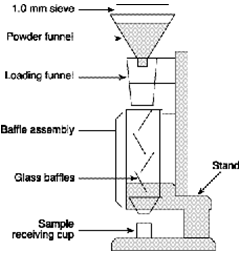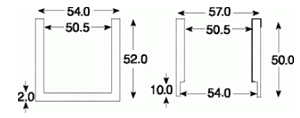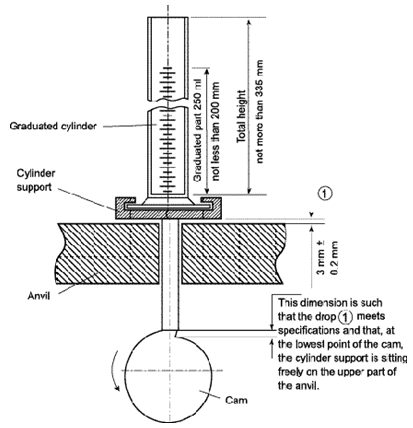Supplementary information: Test methods used during development or manufacture: Bulk density and tapped density of powders
The bulk density of a powder is the ratio of the mass of an untapped powder sample and its volume including the contribution of the interparticulate voidvolume. Hence, the bulk density depends on both the density of powder particles and the spatial arrangement of particles in the powder bed. The bulkdensity is expressed in grams per millilitre (g/mL) although the international unit is kilogram per cubic metre (1 g/mL = 1000 kg/m3) becausethe measurements are made using cylinders.
It may also be expressed in grams per cubic centimetre (g/cm3).
The bulking properties of a powder are dependent upon the preparation, treatment and storage of the sample, i.e. how it was handled. The particles can bepacked to have a range of bulk densities and, moreover, the slightest disturbance of the powder bed may result in a changed bulk density. Thus, the bulkdensity of a powder is often very difficult to measure with good reproducibility and, in reporting the results, it is essential to specify how thedetermination was made.
The bulk density of a powder is determined by measuring the volume of a known mass of powder sample, that may have been passed through a sieve, into agraduated cylinder (Method A) or by measuring the mass of a known volume of powder that has been passed through a volumeter into a cup (Method B) or ameasuring vessel (Method C).
Method A and Method C are favoured.
Method A. Measurement in a graduated cylinder
Procedure. Pass a quantity of powder sufficient to complete the test through a sieve with apertures greater than or equal to 1.0 mm, if necessary, to break upagglomerates that may have formed during storage; this must be done gently to avoid changing the nature of the material. Into a dry graduated cylinder of250 mL (readable to 2 mL) gently introduce, without compacting, approximately 100 g of the test sample (m) weighed with 0.1% accuracy. Carefullylevel the powder without compacting, if necessary, and read the unsettled apparent volume (V0) to the nearest graduated unit. Calculatethe bulk density in (g/mL) using the formula m/V0. Generally, replicate determinations are desirable for the determination ofthis property.
If the powder density is too low or too high, such that the test sample has an untapped apparent volume of either more than 250 mL or less than 150 mL, itis not possible to use 100 g of powder sample. Therefore a different amount of powder has to be selected as test sample, such that its untapped apparentvolume is 150 mL to 250 mL (apparent volume greater than or equal to 60% of the total volume of the cylinder); the mass of the test sample is specified inthe expression of results.
For test samples having an apparent volume between 50 mL and 100 mL a 100 mL cylinder readable to 1 mL can be used; the volume of the cylinder is specifiedin the expression of results.
Method B. Measurement in a volumeter
Apparatus. The apparatus1 (Figure 1) consists of a top funnel fitted with a 1.0 mm sieve. The funnel is mounted over a baffle box containing four glass baffle plates over which thepowder slides and bounces as it passes. At the bottom of the baffle box is a funnel that collects the powder and allows it to pour into a cup mounteddirectly below it. The cup may be cylindrical (25.00 ± 0.05 mL volume with an inside diameter of 30.00 ± 2.00 mm) or cubical (16.39 ± 0.20 mL volume withinside dimensions of 25.400 ± 0.076 mm).

Figure 1. Volumeter
Procedure. Allow an excess of powder to flow through the apparatus into the sample receiving cup until it overflows, using a minimum of 25 cm3 of powderwith the cubical cup and 35 cm3 of powder with the cylindrical cup. Carefully, scrape excess powder from the top of the cup by smoothly movingthe edge of the blade of a spatula perpendicular to and in contact with the top surface of the cup, taking care to keep the spatula perpendicular toprevent packing or removal of powder from the cup. Remove any material from the side of the cup and determine the mass (M) of the powder to thenearest 0.1%. Calculate the bulk density (g/mL) using the formula M/V0 in which V0 is the volume of the cup andrecord the average of three determinations using three different powder samples.
1The apparatus (the Scott Volumeter) conforms to the dimensions in ASTM 329 90.
Method C. Measurement in a vessel
Apparatus. The apparatus consists of a 100 mL cylindrical vessel of stainless steel with dimensions as specified in Figure 2.

Figure 2. - Measuring vessel (left) and cap (right) - dimensions in mm
Procedure. Pass a quantity of powder sufficient to complete the test through a 1.0 mm sieve, if necessary, to break up agglomerates that may have formed duringstorage and allow the obtained sample to flow freely into the measuring vessel until it overflows. Carefully scrape the excess powder from the top of thevessel as described for Method B. Determine the mass (M0) of the powder to the nearest 0.1% by subtraction of the previously determinedmass of the empty measuring vessel. Calculate the bulk density (g/mL) using the formula M0/100 and record the average of threedeterminations using three different powder samples.
TAPPED DENSITY
The tapped density is an increased bulk density attained after mechanically tapping a container containing the powder sample.
The tapped density is obtained by mechanically tapping a graduated measuring cylinder or vessel containing the powder sample. After observing the initialpowder volume or mass the measuring cylinder or vessel is mechanically tapped and volume or mass readings are taken until little further volume or masschange is observed. The mechanical tapping is achieved by raising the cylinder or vessel and allowing it to drop, under its own mass, a specified distanceby either of three methods as described below. Devices that rotate the cylinder or vessel during tapping may be preferred to minimize any possibleseparation of the mass during tapping down.
Method A
Apparatus. The apparatus (Figure 3) consists of the following:
- a 250 mL graduated cylinder (readable to 2 mL) with a mass of 220 ± 44 g;
- a settling apparatus capable of producing in 1 minute either nominally 250 ± 15 taps from a height of 3 ± 0.2 mm or nominally 300 ± 15 taps from a heightof 14 ± 2 mm. The support for the graduated cylinder, with its holder, has a mass of 450 ± 10 g.

Figure 3
Procedure. Proceed as described above for the determination of the bulk volume (V0). Secure the cylinder in the holder. Carry out 10, 500 and1250 taps on the same powder sample and read the corresponding volumes V10, V500 and V1250 to the nearest graduated unit. If the difference between V500 and V1250 is less than or equal to 2 mL, V1250 is the tapped volume. If the difference between V500 and V1250 exceeds 2 mL repeat in incrementssuch as 1250 taps until the difference between succeeding measurements is less than or equal to 2 mL. Fewer taps may be appropriate for some powders, whenvalidated. Calculate the tapped density (g/mL) using the formula m/Vf in which Vf is the final tappedvolume. Generally, replicate determinations are desirable for the determination of this property. Specify the drop height with the results.
If it is not possible to use a 100 g test sample, use a reduced amount and a suitable 100 mL graduated cylinder (readable to 1 mL) weighing 130 ± 16 g andmounted on a holder weighing 240 ± 12 g. The modified test conditions are specified in the expression of the results.
Method B
Procedure. Proceed as directed under Method A except that the mechanical tester provides a fixed drop of 3 ± 0.2 mm at a nominal rate of 250 taps per minute.
Method C
Procedure. Proceed as described in Method C for measuring the bulk density using the measuring vessel equipped with the cap shown in Figure 2. The measuring vesselwith the cap is lifted 50-60 times per minute by the use of a suitable tapped density tester. Carry out 200 taps, remove the cap and carefully scrapeexcess powder from the top of the measuring vessel as described in Method C for measuring the bulk density. Repeat the procedure using 400 taps. If thedifference between the two masses obtained after 200 and 400 taps exceeds 2% carry out a test using 200 additional taps until the difference betweensucceeding measurements is less than 2%. Calculate the tapped density (g/mL) using the formula Mf/100 where Mf isthe mass of powder in the measuring vessel. Record the average of three determinations using three different powder samples. The test conditions includingtapping height are specified in the expression of the results.
MEASURES OF POWDER COMPRESSIBILITY
Because the interparticulate interactions influencing the bulking properties of a powder are also the interactions that interfere with powder flow, acomparison of the bulk and tapped densities can give a measure of the relative importance of these interactions in a given powder. Such a comparison isoften used as an index of the ability of the powder to flow, for example, the Compressibility index or the Hausner ratio.
The Compressibility index and Hausner ratio are measures of the propensity of a powder to be compressed as described above. As such they are measures ofthe powder’s ability to settle and they permit an assessment of the relative importance of interparticulate interactions. In a free-flowing powder, suchinteractions are less significant, and the bulk and tapped densities will be closer in value. For poorer flowing materials there are frequently greaterinterparticulate interactions and a greater difference between the bulk and tapped densities will be observed. These differences are reflected in theCompressibility Index and the Hausner Ratio.
Compressibility index :

|
V0 |
= |
unsettled apparent volume, |
|
Vf |
= |
final tapped volume. |
Hausner Ratio:

Depending on the material the compressibility index can be determined using V10 instead of V0. If V10 is used it is clearly stated in the results.